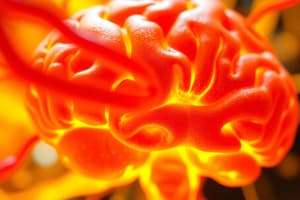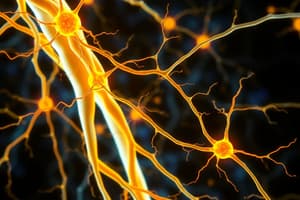Podcast
Questions and Answers
What is the primary function of upper motor neurons (UMNs)?
What is the primary function of upper motor neurons (UMNs)?
- Control movement and inhibit muscle tone. (correct)
- Receive sensory input from the body.
- Directly innervate muscle tissue.
- Facilitate voluntary movement without inhibition.
Which spinal cord tract is primarily responsible for sending signals from the brain to skeletal muscles?
Which spinal cord tract is primarily responsible for sending signals from the brain to skeletal muscles?
- Spinothalamic tract
- Cuneate column
- Corticospinal tract (correct)
- Gracile column
What is the approximate length of the spinal cord in adults?
What is the approximate length of the spinal cord in adults?
- 30 cm
- 45 cm (correct)
- 75 cm
- 60 cm
What type of paralysis is associated with upper motor neuron lesions?
What type of paralysis is associated with upper motor neuron lesions?
Which section does the spinal cord end in adults?
Which section does the spinal cord end in adults?
Where do the lateral corticospinal tracts decussate?
Where do the lateral corticospinal tracts decussate?
What type of information is conveyed by the corticospinal (pyramidal) tract?
What type of information is conveyed by the corticospinal (pyramidal) tract?
Which term describes the type of paralysis that results from lower motor neuron (LMN) lesions?
Which term describes the type of paralysis that results from lower motor neuron (LMN) lesions?
What role do lower motor neurons (LMNs) play in the nervous system?
What role do lower motor neurons (LMNs) play in the nervous system?
What structural feature is associated with the enlargement of the spinal cord?
What structural feature is associated with the enlargement of the spinal cord?
What distinguishes the corticobulbar tract from the corticospinal tract?
What distinguishes the corticobulbar tract from the corticospinal tract?
Which of the following is NOT a meningeal layer surrounding the spinal cord?
Which of the following is NOT a meningeal layer surrounding the spinal cord?
How many pairs of spinal nerves are there in the human body?
How many pairs of spinal nerves are there in the human body?
Which of the following statements about motor neuron lesions is incorrect?
Which of the following statements about motor neuron lesions is incorrect?
What is the primary function of the spinal cord?
What is the primary function of the spinal cord?
Which tract is responsible for the transmission of pain and temperature sensations?
Which tract is responsible for the transmission of pain and temperature sensations?
Where do most corticospinal fibers decussate?
Where do most corticospinal fibers decussate?
What is the primary function of the corticospinal tract?
What is the primary function of the corticospinal tract?
Which cranial nerves are associated with the corticonuclear tract?
Which cranial nerves are associated with the corticonuclear tract?
What occurs to axons in the anterior segment of the corticospinal tract?
What occurs to axons in the anterior segment of the corticospinal tract?
What role does the anterior corticospinal tract primarily serve?
What role does the anterior corticospinal tract primarily serve?
What type of information does the spinothalamic tract primarily carry?
What type of information does the spinothalamic tract primarily carry?
Which of the following statements about motor fibers of cranial nerves is NOT true?
Which of the following statements about motor fibers of cranial nerves is NOT true?
What do axons in the corticospinal tract primarily originate from?
What do axons in the corticospinal tract primarily originate from?
What do the anterior (ventral) rootlets primarily transmit?
What do the anterior (ventral) rootlets primarily transmit?
Which structure is responsible for the transmission of sensory information to the CNS?
Which structure is responsible for the transmission of sensory information to the CNS?
What is the significance of the Cauda Equina?
What is the significance of the Cauda Equina?
What are the primary components of white matter in the spinal cord?
What are the primary components of white matter in the spinal cord?
Which lamina is specifically associated with motor neurons to skeletal muscle?
Which lamina is specifically associated with motor neurons to skeletal muscle?
Which fibers would be classified as ascending tracts in the spinal cord?
Which fibers would be classified as ascending tracts in the spinal cord?
What type of grey matter structure is found in the spinal cord?
What type of grey matter structure is found in the spinal cord?
What are the three columns of white matter found in the spinal cord?
What are the three columns of white matter found in the spinal cord?
Which tract is responsible for conveying proprioceptive information to the cerebellum?
Which tract is responsible for conveying proprioceptive information to the cerebellum?
Which sensory modalities are conveyed by the lateral pathway of the spinothalamic tract?
Which sensory modalities are conveyed by the lateral pathway of the spinothalamic tract?
Where do the dorsal column tracts decussate?
Where do the dorsal column tracts decussate?
What is the role of the Artery of Adamkiewicz?
What is the role of the Artery of Adamkiewicz?
How many neurons are involved in the pathway for pain sensation from the primary afferent neuron to the somatosensory cortex?
How many neurons are involved in the pathway for pain sensation from the primary afferent neuron to the somatosensory cortex?
What type of sensory information does the gracile tract carry?
What type of sensory information does the gracile tract carry?
What is the primary anatomical feature of venous drainage in the spine?
What is the primary anatomical feature of venous drainage in the spine?
Which statement is true regarding spinal sensory pathways?
Which statement is true regarding spinal sensory pathways?
Flashcards are hidden until you start studying
Study Notes
Descending Tracts
- Motor signals from the brain to lower motor neurons
- Found in the white matter of the spinal cord, in the columns (anterior, lateral, posterior)
- Corticospinal Tract
- Lateral Corticospinal Tract: Decussates (crosses over) in the medulla oblongata (pyramids), controls movement of distal extremities
- Anterior Corticospinal Tract: Decussates at the spinal cord segment, controls movement of axial muscles, ( trunk and proximal limbs)
Upper Motor Neurons
- Located in the cerebral cortex and brainstem.
- Responsible for planning, initiating, and controlling voluntary movement and regulating muscle tone.
- Example: The motor cortex is an example of UMNs, which control muscle contraction through the corticospinal tract.
Lower Motor Neurons
- Located in the anterior horn of the spinal cord and cranial nerve nuclei in the brainstem.
- Directly innervate skeletal muscles.
- Responsible for carrying the final signal to muscles for contraction.
- Example: If a lower motor neuron is damaged, the muscle it innervates will become weak or paralyzed.
UMN and LMN Lesions
- UMN Lesions: Result in spastic paralysis (increased muscle tone and hyperreflexia, no muscle wasting). Example: stroke.
- LMN Lesions: Cause flaccid paralysis (decreased muscle tone and reflexes, long-term muscle wasting), Example: Spinal cord injury or nerve damage.
- Spinal Cord and Brainstem Lesions: Damage both LMNs at the level of the lesion and UMNs of all levels below the lesion, also leading to loss of all sensory input at and below the level of the lesion.
Motor Decussations
- Most motor tracts cross over to the opposite side of the body, called decussation.
- The lateral corticospinal tract decussates in the medulla oblongata (pyramids).
- The anterior corticospinal tract decussates at the level of the spinal cord segment.
Corticobulbar Tract
- Controls voluntary movements of the head and face.
- Synapses with nuclei of cranial nerves III, IV, V, VI, VII, IX, X, XI, and XII.
- Example: The corticobulbar tract is responsible for facial expressions, chewing, and swallowing.
Spinothalamic Tract
- Carries sensory information about pain, temperature, itch, and crude touch from the body to the brain.
- Lateral Spinothalamic Tract: Perceives pain and temperature.
- Anterior Spinothalamic Tract: Perceives crude touch.
Spinal Cord
- An elongated cylindrical structure located in the vertebral canal.
- Extends from the medulla oblongata to L2 in adults (L3 in newborns).
- Enlargements: Cervical enlargement (for innervation of the upper limbs) and lumbosacral enlargement (for innervation of the lower limbs).
Meninges
- Dura Mater: Outermost layer, tough and fibrous.
- Arachnoid Mater: Middle layer, delicate and web-like.
- Pia Mater: Innermost layer, thin and vascular, tightly adhered to the spinal cord.
Spinal Nerves
- 31 pairs of spinal nerves, each consisting of an anterior (ventral) root (motor) and a posterior(dorsal) root(sensory).
- The anterior and posterior roots join to form a mixed spinal nerve, which exit the vertebral canal through intervertebral foramen.
- Spinal nerves branch into ventral and dorsal rami, innervating different areas of the body.
Cauda Equina
- Lower nerve roots extend downwards from the conus medullaris, resembling a horse's tail.
- Important for lumbar punctures, epidural anaesthesia, and spinal anaesthesia.
Grey Matter
- Located centrally in the spinal cord, resembling a butterfly or 'H' shape.
- Contains cell bodies of neurons.
- Dorsal Horns: Receive sensory information and relay it to the brain.
- Ventral Horns: Contain motor neurons that send signals to muscles.
White Matter
- Surrounds the grey matter in the spinal cord.
- Contains bundles of axons, which transmit information to and from the brain.
- Arranged into columns (anterior, lateral, posterior).
- Ascending Tracts: Sensory pathways, carry information from the body to the brain.
- Descending Tracts: Motor pathways, carry information from the brain to the body.
Spinal Cord Arterial Supply
- Anterior Spinal Artery: Supplies the anterior two-thirds of the spinal cord.
- Posterior Spinal Arteries: Supply the posterior one-third of the spinal cord.
- Artery of Adamkiewicz: Largest segmental artery, supplies the lower spinal cord, a critical artery.
Spinal Cord Venous Drainage
- Venous drainage is via the internal vertebral venous plexus.
- Valveless, allowing for drainage in both directions (towards the heart and towards the brain).
Studying That Suits You
Use AI to generate personalized quizzes and flashcards to suit your learning preferences.




